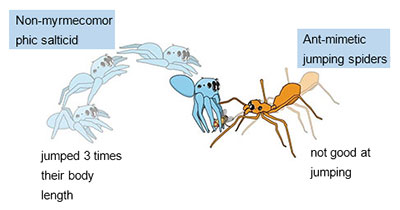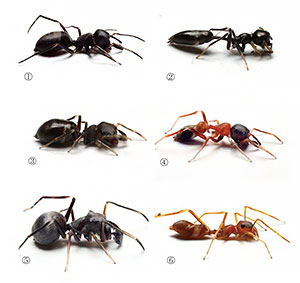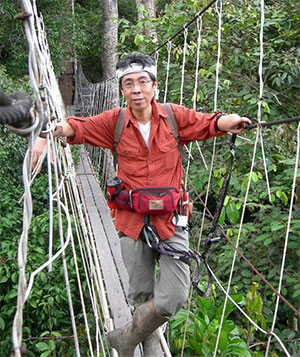News & Topics
The more accurately mimic, the lower performance
Constraints on the jumping and prey‑capture abilities of ant‑mimicking spiders were discovered Report by the SATREPS Malaysia Project
Science and Technology Research Partnership for Sustainable Development(SATREPS)
Yoshiaki Hashimoto (Associate Professor, University of Hyogo/Museum of Nature and Human Activities in Hyogo) discovered that Myrmarachne cost the jumping and prey-capture abilities in return for gaining the defensive effects by accurately mimic of ants. The study started in June 2019 under the environmental and energy project “Development of Management Systems for Multiple Utilization of Biodiversity in the Tropical Rainforests at the Protected Areas in Sarawak”(Principal Investigator Takao Itioka, Professor, Kyoto University) in the framework of the SATREPS program.
Dr. Hashimoto and his group collected 7 Myrmarachne species (86 individuals) and 12 genera of non-myrmecomorphic salticid (70 individuals) inhabited in tropical forests in Malaysian Borneo and Thailand to measure their morphometrical traits using geometric morphometric techniques. In addition, in order to compare the predation abilities of both, they caught each individual preying on a small fly (about 2 mm in length) on a video camera and determined the jumping distance when catching its prey and prey-capture success rates.
The observation found that the non-myrmecomorphic salticid jumped a distance of about three times its body length when catching its prey. On the other hand, Myrmarachne only jumped to distances equal to its body length at the maximum. Some species were observed to jump hardly. In addition, with a decrease in the jumping ability, mimicking the Myrmarachne’s prey-capture success rate was found to be significantly reduced.

Figure 1. Prey-capture behavior of a non-mimic salticid and a mimicked Myrmarachne
Furthermore, among the mimicked Myrmarachne, the Myrmarachne, which mimics an ant with a slender and more constricted body, had lower jumping power and a prey-capture success rate. In other words, it was found that even in the same genus Myrmarachne, the degree of decrease in jumping power and catching prey ability differs depending on the species of ant mimicked.
More than 200 species of Myrmarachne have been identified, and it is known that all species mimic ants to protect themselves from enemies. However, the drawbacks of the mimicking for Myrmarachne had not been identified. The study revealed that accurate mimicry of ants by Myrmarachne spiders is a double-edged sword for Myrmarachne spiders, gaining the defensive effects but constraining the jumping and prey-capture abilities.
This project is planning to aggregate 2D- and 3D-images and video data of the genus Myrmarachne that Dr. Hashimoto collected during the study to a database. The project will accumulate clear image data, video data, and CT images of various species in the database, aiming to construct the biodiversity information platform that researchers worldwide can access in the future.

Figure 2. Studied species of Myrmarachne ant-mimetic jumping spiders collected in Borneo and Thailand. They look like ants at first glance, but they are spiders because they have eight legs. A rich morphological diversity is found in Myrmarachne spiders, such as Myrmarachne that mimic Tetraponera, which have extremely slender and elongated body shapes, and Myrmarachne that mimic of Polyrhachis lamellidens, which have a broader body shape. Among these ants in the picture, the most slender and elongated body shaped ant (2) exhibited the lowest jumping ability.
(1)Myrmarachne acromegalis, (2) M. cornuta, (3) M. hashimotoi, (4) M. melanocephala, (5) M. maxillosa, and (6) M.plataleoides. (Photo credit: Hashimoto Y.)

Dr. Hashimoto crossing the suspension bridge hanging between trees at 30 meters from the ground level.
(Lambir Hills National Park, Sarawak)
- 【Press Information】
- The Museum of Nature and Human Activities, Hyogo:
https://www.hitohaku.jp/research/h-research/20201026news.html
- 【Project Information】
- https://www.jst.go.jp/global/english/kadai/r0102_malaysia.html (EN)
